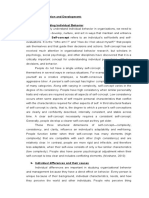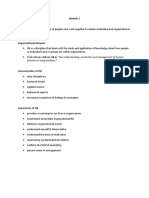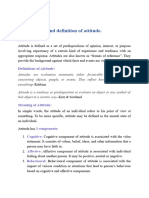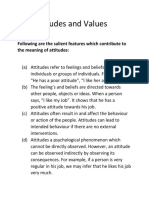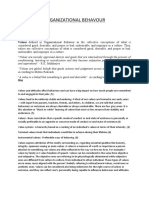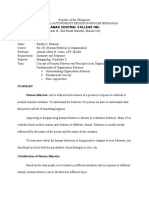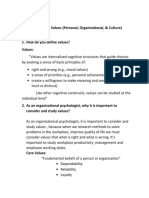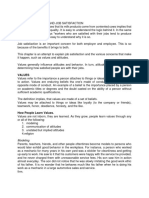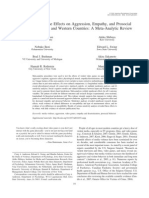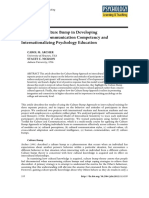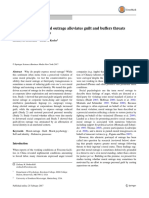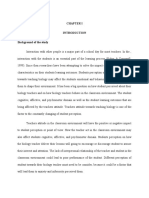Module 4 Draft
Module 4 Draft
Uploaded by
Angel Mae CristobalCopyright:
Available Formats
Module 4 Draft
Module 4 Draft
Uploaded by
Angel Mae CristobalOriginal Title
Copyright
Available Formats
Share this document
Did you find this document useful?
Is this content inappropriate?
Copyright:
Available Formats
Module 4 Draft
Module 4 Draft
Uploaded by
Angel Mae CristobalCopyright:
Available Formats
FM-AA-CIA-15 Rev.
0 10-July-2020
Study Guide in (Mgt 102: Human Behavior in Organization) Module No. 4
STUDY GUIDE FOR MODULE NO. 4
VALUES, ATTITUDES AND JOB SATISFACTION
MODULE OVERVIEW
In life, an individual has his/her own beliefs. It may come from our environment or
where a person lives or from teachings that he/she learns in an institution. Perhaps, you might
have experienced things where you have to decide about a certain thing and you are having
dilemma whether which of those options are you going to take. In that particular situation, you are
being guided by your values.
Values are integral part of living which serves as our guide in decision-making process in
different parts of our lives. This also serves as our foundation that motivate attitudes or actions.
They help us to determine what is essential to us. Values are also referred to as enduring beliefs
that one’s mode of conduct is better than the opposite.
LEARNING OBJECTIVES
By studying this module, you are expected to:
1. Define what values is
2. Discuss the following:
How people learn values
Types of values
Individual versus organizational values
Instrumental versus terminal values
3. Define attitudes
4. List the main components of attitudes
5. Explain how attitudes are formed
6. Identify the most important attitude in the workplace
7. Explain effects of employee attitudes
8. Explain how positive attitudes work for the organization
9. Define job satisfaction
10. Enumerate the factors associated with job satisfaction
11. List ways of measuring job satisfaction
LEARNING CONTENTS
How PEOPLE LEARNED VALUES?
Values are learned throughout living. During childhood, values are influenced by
interpersonal identification with parents. The interaction and communication that occurs
between parent and a child represents certain values in either explicit or implied manner.
The parents are first teachers as they say, thus, they educate their child with what is
PANGASINAN STATE UNIVERSITY 1
FM-AA-CIA-15 Rev. 0 10-July-2020
Study Guide in (Mgt 102: Human Behavior in Organization) Module No. 4
morally right and wrong and give example of behaviors regarding solving everyday
problems. (Podolskiy, 2012).
Here are some common factors that influences one’s values:
Modeling
One can think of this as an environmental factor wherein the value depends on the people
that we know and we make interaction to in our daily life. Parents, teachers, and friends
are just some of people that become models to persons who would later exhibit good
behavior in the workplace. These
Communication of Attitudes
This occurs whenever an individual bases his/her action on what that person hears, read,
and see. The person might adapt to the values that he/she sees on other people.
Unstated but implied attitudes
This refers to values that are affected by attitudes which are implied by way of action
rather than being stated.
Religion
Religion is defined by Science Daily as organized collection of beliefs, cultural systems,
and world views that relates to humanity to an order of existence. The freedom of belief
and religion is expressed and protected under Article 3 Section 5 of 1987 Philippine
Constitution, which states that “No law shall be made respecting an establishment of
religion, or prohibiting the free exercise thereof. The free exercise and enjoyment of
religious profession and worship, without discrimination or preference, shall forever be
allowed.”
In connection to values, a person can learn his/her values from religion.
EFFECT OF VALUE CONGRUENCE AND INCONGRUENCE
PANGASINAN STATE UNIVERSITY 2
FM-AA-CIA-15 Rev. 0 10-July-2020
Study Guide in (Mgt 102: Human Behavior in Organization) Module No. 4
Figure that shows value congruence and incongruence
Since an individual has her/his own set of values, in an organization, there are
values that may or may not be compatible or do not match with the values of
employees. If so, there is value incongruence.
CLASSIFICATION OF VALUES
Espoused values are those that workers in an institution say that they value such
as ethical practice. These are being conveyed on behalf of organization or attributed to
organization. In contrast, enacted values refer to those that are actually reflected in the
actual behavior of the members in an organization. These values are the standards that is
exhibited by a company and the workers in an organization. In other words, espoused are
what they say and enacted are what they do.
INSTRUMENTAL AND TERMINAL VALUES
Instrumental Values
This kind of value refers to types of behavior or means in reaching terminal values.
These also meant the worth of things that provides means to one’s goals and also lead to
satisfaction of human needs and wants. Some examples of these values include self-
sufficiency, courageousness, being obedient, being polite, and honesty.
Terminal Values
These values are those that we think are the most essential throughout our
existence. These also refers to those that we consider the most desirable. Examples of
PANGASINAN STATE UNIVERSITY 3
FM-AA-CIA-15 Rev. 0 10-July-2020
Study Guide in (Mgt 102: Human Behavior in Organization) Module No. 4
these kind of values include freedom, equality, family security, self-respect, and
happiness.
ATTITUDES
Attitude refers to the beliefs and feelings that will determine how a worker
perceives his/her environment, how they act toward a certain scenario, and reflects
behavior. In psychology, an attitude refers to a set of emotions, beliefs, and behaviors on
a certain object, person, thing, or event. These often are the result of experience or
raising, and they can have a powerful influence over behavior.
COMPONENTS OF ATTITUDES
Attitudes are composed of three components namely cognitive, affective, and
behavioral. When we say cognitive, it is related to cognition which is perception or
learning. It refers to the opinion, knowledge, and belief as a part of attitude. The affective
component focuses more on the feelings and emotions. On the other hand, behavioral
component refers to how a person acts or behaves on a particular object or thing.
Figure that illustrates the components of attitude
DIFFERENCES IN PERSONAL DISPOSITION
Disposition refers to an individual’s inherent qualities of character and mind. It is
being defined also as arrangement of people or things in a particular order. People differ
in their personal disposition whether it is more on positive affective attitudes or negatively
affective ones.
PANGASINAN STATE UNIVERSITY 4
FM-AA-CIA-15 Rev. 0 10-July-2020
Study Guide in (Mgt 102: Human Behavior in Organization) Module No. 4
Positive affectivity refers to a personal characteristic or a trait that reflects stable
individual differences in positive emotional experience. It inclines employees to be
predisposed when it comes to work satisfaction. Negative affectivity or also known as
negative affect is a personality variable involved in experiencing negative feelings. In
other words, it is a trait of employees that inclines them to be predisposed to be
dissatisfied at work.
HOW ATTITUDES ARE FORMED
When we acquire information on our environment, we tend to learn those and apply it in
our lives. From that, attitudes regarding different things are formed. There are two
methods in which people get their attitude from. These are the direct experience and
indirect means of social learning. Talking about direct experiences, these refers to
information that people store in their minds. Those attitudes that were formed in indirect
way are those that people learn from their peer groups, religious organizations, and those
people that they interact with in daily living.
People working in this field have suggested that attitudes form for four primary reasons
1. Utilitarian – This is where people tend to form positive attitudes towards things that
will lead to benefit and those negative attitudes to things that they perceive as a
loss.
2. Knowledge – Attitudes help people to make sense of the happenings on our
surroundings via giving them framework to evaluate it.
3. Value-Expressive – People form attitudes that reflect values or which reflect those
social set.
4. Ego-Defensive – People adopt attitude to save themselves from anything which
threatens their ego or sense of self-worth.
5.
MOST IMPORTANT ATTITUDES IN WORKPLACE
There are three significant attitudes that a worker must have in a workplace.
1. Job Satisfaction – This refers to the level of the contentment that the employees
feel about their job.
2. Job involvement – This is defined as state of psychological identification with work
or the degree to which a person recognizes with the job, actively being involved in
it, and one who considers the performance important to self-worth.
PANGASINAN STATE UNIVERSITY 5
FM-AA-CIA-15 Rev. 0 10-July-2020
Study Guide in (Mgt 102: Human Behavior in Organization) Module No. 4
3. Organizational commitment – It is the perspective of an employee on his/her
attachment to the organization where he/she belongs. It also refers to the degree in
which an employee identifies with a certain workplace and its aim in maintaining
membership in that organization.
EFFECT OF EMPLOYEE ATTITUDES
Positive Job Attitude
With this kind of attitude, someone would keep on discovering new things to him/her and
have a mindset where that person feels excited going to work together with co-workers.
Other than that, it indicates job satisfaction.
Negative Job Attitude
Bad attitudes will just make a worker feel dissatisfied on his/her work and by that,
workloads won’t be accomplished. It also includes those that have concerns with job
dissatisfaction and low commitment to the workplace. Having this kind of attitude would
make the employee have psychological withdrawal such as overthinking during office
hours, unnecessary absences and extended breaks.
Figure that shows the effect of employee attitudes on workplace
MAKING POSITIVE ATTITUDES WORK FOR ORGANIZATION
PANGASINAN STATE UNIVERSITY 6
FM-AA-CIA-15 Rev. 0 10-July-2020
Study Guide in (Mgt 102: Human Behavior in Organization) Module No. 4
By making positive attitudes work for organization, the group can be more
productive, satisfied, and successful in their organization. Those who are in-charge of
hiring an employee must make positive work attitudes as a requirement before
employment offers while those who have negative attitudes in workplace must be
managed by the employer through making them join in programs or seminars designed to
change the negative work. Another way is by making a reward system because this will
motivate and further encourage an employee to increase his/her performance.
BENEFITS OF JOB SATISFACTION
- better life satisfaction
- increased productivity
- loyalty to the company
- improved safety performance
- low absenteeism and turnover
- not prone to stress and burnout
- a stronger tendency to achieve customer loyalty
-
FACTORS ASSOCIATED WITH JOB SATISFACTION
1. Salary – adequate payment and perceived equity compared to others
2. Work itself – It is the extent in which job tasks are considered interesting and
provide opportunities for learning
3. Promotion and opportunity – This refer to the chances for further advancement
4. Quality of Supervision – It meant the competence on interpersonal skills of the
head of an organization on how that person manages his/her team to work in unity.
5. Relationship with co-workers – This is where the team are supportive and friendly
to each other.
6. Working conditions – It is the extent in which the environment is a factor for the
betterment of productivity.
7. Job Security – It is the belief where one’s position is relatively secured and
continued employment with the organization.
WAYS OF MEASURING JOB SATISFACTION
PANGASINAN STATE UNIVERSITY 7
FM-AA-CIA-15 Rev. 0 10-July-2020
Study Guide in (Mgt 102: Human Behavior in Organization) Module No. 4
Measuring job satisfaction is a crucial process but it will lead to making ways for
the improvement of an organization on achieving particular tasks. The first method is
single global rating which refers to the approach where employees are asked to respond
to a question. Another one is the summation score method which refers to an approach
where workers indicate their feelings on each key factors of their work.
CATERGORIES OF ORGANIZATIONAL COMMITMENT
Organizational commitment is classified into three which are the affective,
continuance, and normative. Affective commitment is defined as the individual’s
attachment of feelings to the organization and belief in its values. Continuance
commitment refers to the individual’s tendency to endure and remain on his post because
he/she cannot afford to leave. Normative commitment refers to an obligation to remain on
the organization because of ethical or moral reasons.
SUMMARY
Values, attitudes and job satisfaction of employees are essential concerns of
leaders in the organization
Values are guidelines and beliefs that an individual use when confronted with
situation in which a choice must be made
Values maybe learned through modeling, communication of attitudes, unstated but
implied attitudes and religion
Attitudes reflects how one feel about something
The most important attitudes in the workplace are those concerning job
satisfaction, job involvement, and organizational commitment
LEARNING ACTIVITIES
PANGASINAN STATE UNIVERSITY 8
FM-AA-CIA-15 Rev. 0 10-July-2020
Study Guide in (Mgt 102: Human Behavior in Organization) Module No. 4
ACTIVITY 1
Illustrated below is a Frayer Model Map. Based on what you’ve learned in this module,
explain your understanding of the terms in the middle and write the details for each
quadrant. (5 points each)
Definition: Characteristics
VALUES
Examples: Non-examples:
Definition: Characteristics
ATTITUDE
Examples: S Non-examples:
PANGASINAN STATE UNIVERSITY 9
FM-AA-CIA-15 Rev. 0 10-July-2020
Study Guide in (Mgt 102: Human Behavior in Organization) Module No. 4
Definition: Characteristics
JOB
Examples: SATISFACTIO Non-examples:
N
Definition: Characteristics
ORGANIZATIONAL
Examples: COMMITMENT Non-examples:
ACTIVITY 2
Answer the following questions briefly but intelligently. (3 points each)
1. Enumerate and elaborate at least three factors associated with job satisfaction.
__________________________________________________________________
__________________________________________________________________
__________________________________________________________________
__________________________________________________________________
PANGASINAN STATE UNIVERSITY 10
FM-AA-CIA-15 Rev. 0 10-July-2020
Study Guide in (Mgt 102: Human Behavior in Organization) Module No. 4
__________________________________________________________________
____________________
2. Differentiate the two classification of values.
__________________________________________________________________
__________________________________________________________________
__________________________________________________________________
__________________________________________________________________
__________________________________________________________________
____________________
3. What do you think is the two most important benefit of job satisfaction? Justify your
answers.
__________________________________________________________________
__________________________________________________________________
__________________________________________________________________
__________________________________________________________________
__________________________________________________________________
____________________
4. How are instrumental and terminal values differ from each other?
__________________________________________________________________
__________________________________________________________________
__________________________________________________________________
__________________________________________________________________
__________________________________________________________________
____________________
5. Explain at least three common factors that influences one’s values.
__________________________________________________________________
__________________________________________________________________
__________________________________________________________________
__________________________________________________________________
__________________________________________________________________
____________________
6. Explain your understanding on the categories of organizational commitment.
PANGASINAN STATE UNIVERSITY 11
FM-AA-CIA-15 Rev. 0 10-July-2020
Study Guide in (Mgt 102: Human Behavior in Organization) Module No. 4
__________________________________________________________________
__________________________________________________________________
__________________________________________________________________
__________________________________________________________________
__________________________________________________________________
____________________
7. How are values, attitudes, and job satisfaction related to each other?
__________________________________________________________________
__________________________________________________________________
__________________________________________________________________
__________________________________________________________________
__________________________________________________________________
____________________
8. What do you think will be the effect in an organization of having at least one
individual that has negative job attitude?
__________________________________________________________________
__________________________________________________________________
__________________________________________________________________
__________________________________________________________________
__________________________________________________________________
____________________
9. Elaborate how attitudes are formed from the four primary reasons discussed in this
module.
__________________________________________________________________
__________________________________________________________________
__________________________________________________________________
__________________________________________________________________
__________________________________________________________________
____________________
10. What do you think is the major reason why some organizations fail to be efficient
and productive? Does it have any connection with attitudes or satisfaction? Explain
why.
PANGASINAN STATE UNIVERSITY 12
FM-AA-CIA-15 Rev. 0 10-July-2020
Study Guide in (Mgt 102: Human Behavior in Organization) Module No. 4
__________________________________________________________________
__________________________________________________________________
__________________________________________________________________
__________________________________________________________________
__________________________________________________________________
____________________
ACTIVITY 3
Write T if the statement given is true and F if otherwise. If the item is false, change the
word/s to make the statements correct. Write your answers on the space provided before
each item. (2 points each)
____________________1. Disposition inclines employees to be predisposed when it
comes to work satisfaction.
____________________2. Negative effectivity or also known as negative affect is a
personality variable involved in experiencing negative feelings.
____________________3. An obligation to remain on the organization because of ethical
or moral reasons is continuance commitment.
____________________4. Affective commitment refers to the degree in which an
employee identifies with a certain workplace and its aim in maintaining membership in
that organization
____________________5. By making positive attitudes work for organization, the group
can be unproductive, dissatisfied, and unsuccessful in their organization.
____________________6. Job involvement is a component of attitude that is defined as
state of psychological identification with work or the degree to which a person recognizes
with the job, actively being involved in it, and one who considers the performance
important to self-worth
____________________7. Value Expressive where people tend to form positive attitudes
towards things that will lead to benefit and those negative attitudes to things that they
perceive as a loss.
____________________8. Affective component is one of the components of attitude that
focuses on how a person behaves on particular thing.
____________________9. Quality of supervision is the belief where one’s position is
relatively secured and continued employment with the organization
PANGASINAN STATE UNIVERSITY 13
FM-AA-CIA-15 Rev. 0 10-July-2020
Study Guide in (Mgt 102: Human Behavior in Organization) Module No. 4
____________________10. Since an individual has her/his own set of values, in an
organization, there are values that may or may not be compatible or do not match with the
values of employees. If so, there is value incongruence.
ACTIVITY 4
Create a concept map connecting at least fifteen significant terms (e.g. job satisfaction,
organizational commitment, attitude) discussed in this module. (30 points)
PANGASINAN STATE UNIVERSITY 14
FM-AA-CIA-15 Rev. 0 10-July-2020
Study Guide in (Mgt 102: Human Behavior in Organization) Module No. 4
REFERENCES
BOOK REFERENCES
Banfield Paul, Introduction to Human Resource Management, 3rd ed, , Oxford University
Press,2018
Martin,Graeme, Siebet Sabina, Managing People and Organizations in Changing Context,
Routledge, 2016
Medina, Roberto G., Human Behavior in Organization, Rex Bookstore,2011
Zarate, Cynthia, Organizational Behavior and Management in Philippine Organizations,
Rex Bookstore
ELECTRONIC REFERENCES
Judge, T. Robins, S.Organizational Behavior(17th ed).Pearson education limited, 2017
Cherry K. (2020). Attitudes and Behavior in Psychology. Retrieved from
https://www.verywellmind.com/attitudes-how-they-form-change-shape-behavior-2795897
Khandelwal K. & Mohendra N. (2010). Espoused Organizational Values, Vision, and
Corporate Social Responsibility: Does it Matter to Organizational Members? Retrieved
from https://journals.sagepub.com/doi/pdf/10.1177/0256090920100302
McLintic M. How attitudes are formed and predict our behavior. Retrieved from
https://www.firebrand.marketing/2016/08/how-attitudes-are-formed/#:~:text=An%20attitude
%20is%20an%20enduring,stimuli%20and%20make%20an%20evaluation.&text=As
%20we%20experience%20the%20world,these%20then%20affect%20our%20behavior.
PANGASINAN STATE UNIVERSITY 15
FM-AA-CIA-15 Rev. 0 10-July-2020
Study Guide in (Mgt 102: Human Behavior in Organization) Module No. 4
Mintz S. (2018). What are Values? Retrieved from
https://www.ethicssage.com/2018/08/what-are-values.html#:~:text=Values%20are%20the
%20motive%20behind,is%20important%20in%20each%20context.
Podolskiy D. (2012) Value Learning. In: Seel N.M. (eds) Encyclopedia of the Sciences of
Learning. Springer, Boston, MA. https://doi.org/10.1007/978-1-4419-1428-6_1112
Watson D. & Naragon K. (2009). Positive Affectivity: The Disposition to Experience
Positive Emotional States. Retrieved from
https://www.oxfordhandbooks.com/view/10.1093/oxfordhb/9780195187243.001.0001/oxfor
dhb-9780195187243-e-019#:~:text=Positive%20affectivity%20is%20a
%20trait,cheerfulness%2C%20enthusiasm%2C%20and%20energy.
PANGASINAN STATE UNIVERSITY 16
You might also like
- Theories of Housing StudiesDocument10 pagesTheories of Housing StudiesKarisa Magnaye100% (2)
- Clint Fuhs - An Integral Map of Perspective-Taking-AppendixDocument52 pagesClint Fuhs - An Integral Map of Perspective-Taking-AppendixZaq Mosher100% (1)
- Discussions and ReviewsDocument8 pagesDiscussions and ReviewsRose John SupranesNo ratings yet
- By Anoop MohanDocument19 pagesBy Anoop MohanSuma Latha NaiduNo ratings yet
- Employee Motivation and DevelopmentDocument13 pagesEmployee Motivation and DevelopmentAyrle FuentesNo ratings yet
- Organisational Behaviour NOTESDocument31 pagesOrganisational Behaviour NOTESkumarsahilkhan42No ratings yet
- Organisational BehaviorDocument20 pagesOrganisational BehaviorshwetaixixNo ratings yet
- Organization: Behavior in Organizations."Document9 pagesOrganization: Behavior in Organizations."Jahnvi SunderkaNo ratings yet
- A Study On Employee Attitude On Presidency Kid Leather LimitedDocument81 pagesA Study On Employee Attitude On Presidency Kid Leather LimitedBhaktha RagavanNo ratings yet
- Individual and Group Behaviour in An OrganizationDocument8 pagesIndividual and Group Behaviour in An OrganizationpiusNo ratings yet
- Assignments Part I Papers of ISTD Diploma Programme, 2012 January BatchDocument20 pagesAssignments Part I Papers of ISTD Diploma Programme, 2012 January Batchrukmanbgh12100% (1)
- P614 625Document12 pagesP614 625city9848835243 cyberNo ratings yet
- Chapter 4: Values, Attitudes, and Job SatisfactionDocument10 pagesChapter 4: Values, Attitudes, and Job SatisfactionShy CabuenasNo ratings yet
- A Study On Employees' Attitude Towards The Organisation With Special Reference To Sakthi Sugars LTD., Sakthi NagarDocument46 pagesA Study On Employees' Attitude Towards The Organisation With Special Reference To Sakthi Sugars LTD., Sakthi NagarSUKUMAR90% (29)
- Module 2 NotesDocument22 pagesModule 2 Notessnehal.khadgeNo ratings yet
- Chapter-1 Employee Attitude AttitudeDocument26 pagesChapter-1 Employee Attitude AttitudeKrishna RajNo ratings yet
- MarketingDocument11 pagesMarketingLUCIFERNo ratings yet
- Unit 3 Notes Mba 1-1Document10 pagesUnit 3 Notes Mba 1-1ARAYN DIXITNo ratings yet
- Module 3 CCICASDocument4 pagesModule 3 CCICASAryan DasNo ratings yet
- Unit-2 Foundations of Individual BehaviorDocument8 pagesUnit-2 Foundations of Individual BehaviorBhabuk RijalNo ratings yet
- Bekele AssignmentDocument9 pagesBekele Assignmenttsegab bekeleNo ratings yet
- Organisation (Industrial) Psychology Lecture NotesDocument41 pagesOrganisation (Industrial) Psychology Lecture NotesIkechukwu PreciousNo ratings yet
- Attitude Towards OrganizationDocument42 pagesAttitude Towards Organizationchinmay kumar mishra100% (1)
- Leadership Course WorkDocument17 pagesLeadership Course WorkAchilles Kakungulu RichardNo ratings yet
- Study Guide - Chapters 1-3Document8 pagesStudy Guide - Chapters 1-3sheiji_roNo ratings yet
- Organisational BehaviourDocument18 pagesOrganisational Behaviouryadavsujay93No ratings yet
- CHAPTER 3 AttitudeDocument6 pagesCHAPTER 3 AttitudeManisha SurtiNo ratings yet
- HBO September 24 2022 Foundations of Individual BehaviorDocument142 pagesHBO September 24 2022 Foundations of Individual BehaviorOreo The LabradorNo ratings yet
- Business Essentials 11th Edition Ebert Solutions Manual 1Document21 pagesBusiness Essentials 11th Edition Ebert Solutions Manual 1lida100% (50)
- Module-2 - Attitude and BehaviourDocument10 pagesModule-2 - Attitude and Behaviourharshini kishore singhNo ratings yet
- OB - Notes-MBA-1 - Unit 1,2Document9 pagesOB - Notes-MBA-1 - Unit 1,2DishuNo ratings yet
- Lec 9,10,11Document17 pagesLec 9,10,11mazenaymansolimanNo ratings yet
- MAN's Behaviour - ETHICSDocument10 pagesMAN's Behaviour - ETHICSVanito SwabeNo ratings yet
- Personality DevelopmentDocument17 pagesPersonality Developmentfshe26No ratings yet
- Chapter 1 The Nature and Scope of Organizational BehaviorDocument16 pagesChapter 1 The Nature and Scope of Organizational BehaviorFord OsipNo ratings yet
- Org. BehaviourDocument15 pagesOrg. BehaviourParth SharmaNo ratings yet
- Attitudes & Job SatisfactionDocument44 pagesAttitudes & Job SatisfactionÃã Kâã Sh100% (1)
- Attitudes: What Are They?Document14 pagesAttitudes: What Are They?Archana NairNo ratings yet
- Terminal ValuesDocument36 pagesTerminal Valuesdagadivya08No ratings yet
- Attitude and Values: RASHMI-092601069 SUPRITHA-092601070 SHRUTHIKA-092601077 SUSHMITHA-092601073 PRATHEEKSHA-092601125Document33 pagesAttitude and Values: RASHMI-092601069 SUPRITHA-092601070 SHRUTHIKA-092601077 SUSHMITHA-092601073 PRATHEEKSHA-092601125pratham88No ratings yet
- Organizational BehavourDocument5 pagesOrganizational BehavourPRAJWALNo ratings yet
- Project Reports On Employee Attitude Towards The OrganizationDocument47 pagesProject Reports On Employee Attitude Towards The OrganizationVinod Bawane100% (1)
- Wa0026.Document6 pagesWa0026.sibghamehboob6No ratings yet
- HBO Final ExamDocument71 pagesHBO Final ExamFaidah Palawan AlawiNo ratings yet
- HBO - Group Activity 3Document5 pagesHBO - Group Activity 3Ktine JaranillaNo ratings yet
- Understanding and Managing Individual BehaviourDocument25 pagesUnderstanding and Managing Individual Behaviour58 Ajay YadavNo ratings yet
- Psychology 1Document4 pagesPsychology 1adil khanNo ratings yet
- Unit 4 Understanding Human Behaviour: ObjectivesDocument17 pagesUnit 4 Understanding Human Behaviour: ObjectivesilasehrawatNo ratings yet
- Ob 2007 PGDocument222 pagesOb 2007 PGTedros AbrehamNo ratings yet
- HBO PrelimDocument11 pagesHBO PrelimIshi De JuanNo ratings yet
- Chapter 4.-WPS OfficeDocument6 pagesChapter 4.-WPS OfficeMohamed Hassan Mohamed KulmiyeNo ratings yet
- Attitude - Towards - Organization Komal Project (1) - 230326 - 105719Document60 pagesAttitude - Towards - Organization Komal Project (1) - 230326 - 105719Shubham YadavNo ratings yet
- HBO Chap4Document9 pagesHBO Chap4Art Tumakay RabinoNo ratings yet
- Chapter 1Document8 pagesChapter 1Anna Marie Siccuan-UyNo ratings yet
- Values, Attitude and Job SatisfactionDocument6 pagesValues, Attitude and Job SatisfactionChino Pacia100% (1)
- Attitudes and ValuesDocument26 pagesAttitudes and ValuesGautham Karuna100% (2)
- Organizational Behavior: Personal Learning PaperDocument16 pagesOrganizational Behavior: Personal Learning Paperankan_jbNo ratings yet
- Motivation: How to Develop an Inner Fire That Helps You Achieve Your GoalsFrom EverandMotivation: How to Develop an Inner Fire That Helps You Achieve Your GoalsNo ratings yet
- Where Does It Hurt?: Health and Disharmony in Organizational EcosystemsFrom EverandWhere Does It Hurt?: Health and Disharmony in Organizational EcosystemsNo ratings yet
- Violent Video Game Effects On Aggression, Empathy, and Prosocial Behavior in Eastern and Western Countries: A Meta-Analytic ReviewDocument23 pagesViolent Video Game Effects On Aggression, Empathy, and Prosocial Behavior in Eastern and Western Countries: A Meta-Analytic ReviewDavid Chambers100% (3)
- Film As A Media of Internalization of Cultural Values For Millennial Generation in IndonesiaDocument5 pagesFilm As A Media of Internalization of Cultural Values For Millennial Generation in IndonesiaNicole Oliva De la CruzNo ratings yet
- Dahl, Reconstructing and Deconstructing The Self PDFDocument9 pagesDahl, Reconstructing and Deconstructing The Self PDFrachel.avivNo ratings yet
- Product AttachmentDocument14 pagesProduct AttachmentRaluca NicolaeNo ratings yet
- Affective FactorsDocument30 pagesAffective FactorsWilton Daniel GuerreroNo ratings yet
- Cognitive, Affective, and PsychomotorDocument10 pagesCognitive, Affective, and PsychomotormonicaNo ratings yet
- Framing Persuasive Appeals: Episodic and Thematic Framing, Emotional Response, and Policy OpinionDocument24 pagesFraming Persuasive Appeals: Episodic and Thematic Framing, Emotional Response, and Policy OpinionMarkoff ChaneyNo ratings yet
- The Role of Culture Bump in Developing Intercultural Communication Competency and Internationalizing Psychology EducationDocument9 pagesThe Role of Culture Bump in Developing Intercultural Communication Competency and Internationalizing Psychology EducationSyahid Khusnul KhotimahNo ratings yet
- Barbaras - Affectivity and MovementDocument14 pagesBarbaras - Affectivity and MovementjackmackrelNo ratings yet
- Evaluation Techniques For Affective ObjectivesDocument15 pagesEvaluation Techniques For Affective ObjectivesAnne MoralesNo ratings yet
- Toward A Social Psychology of Loneliness (Pág. 31... )Document13 pagesToward A Social Psychology of Loneliness (Pág. 31... )Marcio LacerdaNo ratings yet
- Disturbed Body Image NCPDocument3 pagesDisturbed Body Image NCPBrio Josh60% (5)
- Personalitatea: Table 19.1 Brief Descriptions of Major Maladaptive and Normative Personality Domains (Five-Factor Level)Document4 pagesPersonalitatea: Table 19.1 Brief Descriptions of Major Maladaptive and Normative Personality Domains (Five-Factor Level)EmiNo ratings yet
- A Cleansing Fire - Moral Outrage Alleviates Guilt and Buffers Threats To One's Moral IdentityDocument21 pagesA Cleansing Fire - Moral Outrage Alleviates Guilt and Buffers Threats To One's Moral IdentityelvisesceNo ratings yet
- Widdowson 2014Document14 pagesWiddowson 2014UrosNo ratings yet
- The Effects of Social MediaDocument9 pagesThe Effects of Social MediaJarlene Rodrigues ReisNo ratings yet
- Programme Psy Congress IstanbulDocument202 pagesProgramme Psy Congress IstanbulYouri IanakievNo ratings yet
- The Students Attitude Towards Learning English in Relation To Their Learning Strategies and AchievementDocument10 pagesThe Students Attitude Towards Learning English in Relation To Their Learning Strategies and AchievementIohannes Rufus AlmariegoNo ratings yet
- Subject-Matter: and AffectiveDocument16 pagesSubject-Matter: and Affectiveprofesor derechoNo ratings yet
- Consumer Behavior RevisionDocument12 pagesConsumer Behavior RevisionzebcruikNo ratings yet
- Chapter 5 HandoutsDocument9 pagesChapter 5 HandoutsAngelica TalaveraNo ratings yet
- 08Document18 pages08Mukesh ManwaniNo ratings yet
- Week 7 Health EducationDocument38 pagesWeek 7 Health EducationMohd ArifNo ratings yet
- Chapter 1-3Document31 pagesChapter 1-3MaddyNo ratings yet
- Document YyDocument26 pagesDocument YyLino Magbanua NavallascaNo ratings yet
- TEACHERS GUIDE Caring Thinking ModelDocument3 pagesTEACHERS GUIDE Caring Thinking ModelEvelyn Grace Talde Tadeo100% (1)
- Scriven - 1991 - Evaluation Thesaurus PDFDocument183 pagesScriven - 1991 - Evaluation Thesaurus PDFJuan Pablo Correa100% (1)
- Openness To Experience, Extraversion, and Subjective Well-Being Among Chinese College Students The Mediating Role of Dispositional AweDocument26 pagesOpenness To Experience, Extraversion, and Subjective Well-Being Among Chinese College Students The Mediating Role of Dispositional AweGeorges El NajjarNo ratings yet




